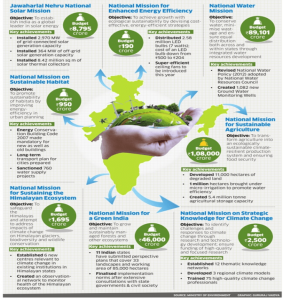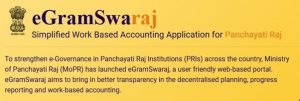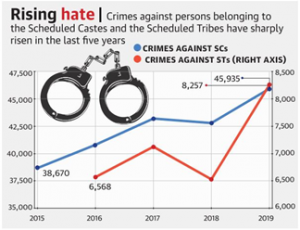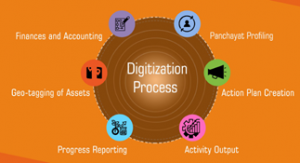THE INDIAN POLITY AND GOVERNANCE
WINTER PARLIAMENT PROCEEDINGS 2021
THE CONTEXT: Over 5 million hectares of agricultural area was affected due to heavy rains during 2021, according to a written reply in the Lok Sabha by the Union Minister of Agriculture and Farmers’ Welfare.
THE EXPLANATION:
- The 50.4 lakh hectare area was affected due to cyclonic storms/flash floods/floods/landslides / cloudburst and others as of November 25, 2021, was from a total of 20 states.
- Karnataka was the worst hit, with crop loss on 4 million ha area, followed by Rajasthan (679,000 ha), West Bengal (690,000 ha), Bihar (580,000 ha), Maharashtra (455,000 ha). Other states included Tamil Nadu, Gujarat, Madhya Pradesh, Odisha among others.
- Rains have wreaked havoc on almost all of these states, which received either ‘large excess’ or ‘excess’ rainfall this year.
- Karnataka, which has the highest area under crop damage, for example, received 102 per cent excess rainfall from October-November, according to data by the Indian Meteorological Department.
- In the absence of any adaptation measures, yields of rainfed and irrigated rice, wheat and Kharif maize are likely to be reduced under projected climate change scenarios.
- The Government under the National Mission for Sustainable Agriculture, one of the eight missions under the National Action Plan on Climate Change (NAPCC), is addressing the risk associated with climate change by devising appropriate adaptation and mitigation strategies, ensuring food security in the country.
- To support the objectives of NAPCC, 33 states and union territories have already prepared their State Action Plan on Climate Change to address state-specific actions.
National Innovations in Climate Resilient Agriculture
- Indian Council of Agricultural Research (ICAR), Ministry of Agriculture and Farmers Welfare, Government of India launched a flagship network project ‘National Innovations in Climate Resilient Agriculture (NICRA) in 2011.
- The project aims at strategic research on adaptation and mitigation, demonstration of technologies on farmers’ fields and creating awareness among farmers and other stakeholders to minimize the climatic change impacts on agriculture.
- In the strategic research, the main thrust areas covered are (i) identifying the most vulnerable districts/regions, (ii) evolving crop varieties and management practices for adaptation and mitigation, (iii) assessing climate change impacts on livestock, fisheries and poultry and identifying adaptation strategies.
National Action Plan on Climate Change (NAPCC)
It was launched in 2008 by the Prime Minister’s Council on Climate Change.
It aims at creating awareness among the representatives of the public, different agencies of the government, scientists, industry and the communities on the threat posed by climate change and the steps to counter it. There are 8 National Missions.

CASTE DISCRIMINATION
THE CONTEXT: A scheduled caste (SC) person faced crime every 10 minutes in India in the past year, cumulating to a total of 50,291 cases registered in 2020, an increase of 9.4% from the previous year, data from the National Crime Records Bureau.
THE EXPLANATION:
- Uttar Pradesh constituted 25% of all crimes recorded against SCs and reported 12,714 cases in all. It was followed by Bihar (7,368), Rajasthan (7,017) and Madhya Pradesh (6,899).

- Together, these four states account for two-thirds of all crimes against SCs in India despite accounting for only around 40% of the country’s 197 million scheduled caste people.
- The rate of crimes – which is a measure of crime cases relative to the population of SC — was highest in Rajasthan, followed by Madhya Pradesh and Bihar.
- In 2020, a total of 1,485 crimes against SCs were registered in India’s 19 metropolitan cities with a population of two million or more – indicating that 97% of the crimes against Dalits occurred in small towns and villages.
- The nature of crimes against SCs in big cities was also different. In the 20 big towns, criminal intimidation and rape were the most common crimes against Dalits. Overall, simple hurt and atrocities cases were the most common.
- The court pendency rate of cases, especially in cases filed under the Scheduled Caste and Scheduled Tribe (Prevention of) Atrocities Act, continues to below. This also confirms standalone reports of cases of major caste crimes taking years to reach the final stage in courts and the difficulty faced by Dalits in proving crimes against upper-castes.
- The court pendency rate of cases under the SC/ST Act stood at 96.5% in 2020, up from 94% last year. At the end of the year, 177,379 cases were pending trial under the special legislation meant to protect the marginal castes and tribes.
- As per the data provided by the National Crime Records Bureau, Ministry of Home Affairs, the total number of cases registered under these Acts for crime/atrocities against the members of SCs and STs in the last two years are as under:-
| Year | Cases registered under the PCR Act, 1955 | Cases registered under the SC/ST (PoA) Act, 1989 (with IPC) |
| 2019 | 16 | 49608 |
| 2020 | 25 | 53886 |
Protection of Civil Rights Act, 1955
In 1976, the Untouchability (Offences ) Act, 1955 has been comprehensively amended and renamed as the Protection of Civil Rights Act, 1955 to enlarge the scope and make penal provisions more stringent. The act defines a civil right as any right accruing to a person by reason of the abolition of untouchability by Article 17 of the Constitution.
The Protection of Civil Rights Act (1955) declares the following acts as offences:\
- preventing any person from entering any place of public worship or from worshipping therein;
- justifying untouchability on traditional, religious, philosophical or other grounds;
- denying access to any shop, hotel or places of public entertainment;
- insulting a person belonging to a scheduled caste on the ground of untouchability;
- refusing to admit persons in hospitals, educational institutions or hostels established for public benefit;
- preaching untouchability directly or indirectly;
- refusing to sell goods or render services to any person.
The Scheduled Castes and the Scheduled Tribes (Prevention of Atrocities) {PoA} Act, 1989.
It known as the SC/ST Act was enacted to protect the marginalized communities against discrimination and atrocities.
- The Act lists various offences relating to various patterns or behaviours inflicting criminal offences and breaking the self-respect and esteem of the scheduled castes and tribes community, which includes denial of economic, democratic, and social rights, discrimination, exploitation, and abuse of the legal process.
- Under section 18 of the act, the provision for anticipatory bail is not available to the offenders.
- Any public servant, who deliberately neglects his duties under this act, is liable to punishment with imprisonment for up to 6 months.
SC/ST Prevention of Atrocities (Amendment) Act, 2015
Scheduled Castes and the Scheduled Tribes (Prevention of Atrocities) Amendment Act, 2015 was introduced to make the act more stringent with the following provisions:
- It recognized more instances of “atrocities” as crimes against SCs and STs.
- It provided for the establishment of exclusive special courts and special public prosecutors to try offences under the PoA Act.
- Act defined the term ‘wilful negligence’ in the context of public servants at all levels, starting from the registration of the complaint to dereliction of duty under this Act.
- If the accused was acquainted with the victim or his family, the court will presume that the accused was aware of the caste or tribal identity of the victim unless proved otherwise.
2018 SC judgment
Supreme Court in its Kashinath Mahajan judgment, introduced the following safeguards to the accused under SC/ST act.
Key guidelines
- The bar on anticipatory bail under the Act need not prevent courts from granting advance bail if there is no merit in a complaint
- “Preliminary enquiry” to be conducted in all cases before registration of FIRs.
- The person can be arrested by an investigating officer, only if the “appointing authority” (in the case of a public servant) or the SP (in the case of others) approves such arrest.
2018 amendment to the Act
In 2018, in response to this dilution of the act and public uproar against it, Parliament introduced Section 18A to overturn safeguards introduced by the Supreme Court.
- The preliminary inquiry shall not be required for registration of a First Information Report against any person.
- No approval is required before the arrest of the accused under this act.
- It rules out any provision (Section 438 of the CrPC that deals with anticipatory bail) for anticipatory bail for the accused.
E-GOVERNANCE OF PANCHAYATS
THE CONTEXT: According to the Ministry of Panchayat, Currently, 2,58,694 Panchayati Raj Institutions have prepared Panchayat Development Plans for Financial Year 2021-22 and 2,75,252 Panchayati Raj Institutions have adopted eGramSwaraj for the purpose of accounting. Further, 2,53,523Panchayati Raj Institutions have on boarded eGramSwaraj-PFMS Interface for carrying out online transactions.
THE EXPLANATION:

- No direct financial assistance is provided to States / UTs for the implementation of e-governance in the Panchayats under the e-Panchayat Mission Mode Project.
- Ministry of Panchayati Raj (MoPR) has been providing programmatic support for the strengthening of Panchayati Raj Institutions (PRIs) and capacity building of Elected Representatives and functionaries of PRIs to improve their functioning and effectiveness and make them self-reliant.
-

Panchayat being a State subject, providing basic infrastructure facilities including computers, electric power supply etc. is primarily the responsibility of concerned State Government / UT Administration for the proper working of e-governance of panchayats.
About Panchayati Raj Institutions:
- Panchayati Raj Institution (PRI) is a system of rural local self-government in India.
Local Self Government is the management of local affairs by such local bodies who have been elected by the local people.PRI was constitutionalized through the 73rd Constitutional Amendment Act, 1992 to build democracy at the grassroots level and was entrusted with the task of rural development in the country.
- In its present form and structure, PRI has completed 28 years of existence. However, a lot remains to be done in order to further decentralization and strengthen democracy at the grass-root level.
THE ENVIRONMENT AND ECOLOGY
SOUTH AFRICA’S WHITE RHINOS’ TRANSLOCATION
THE CONTEXT: South Africa flies 30 white rhinos to Rwanda, this was the largest single transfer of white rhinos ever undertaken. The species is threatened by illegal poaching.
THE EXPLANATION:

- The animals traveled 3,400 kilometers from South Africa’s Phinda Private Game Reserve to Akagera National Park in eastern Rwanda.
- They embarked on this 40-hour journey after months of preparation, said charity African Parks, which was involved in the operation.
Why were the rhinos transferred?
- It was part of a program to replenish the white rhino population, decimated by poaching since the 1970s.
- Also reintroduced to the Akagera National Park were lions and black rhinos, species which went extinct in the area due to poaching and destruction of habitat in the 1980s and 90s.
- The park also hosts African elephants, African buffalo, Masai giraffes and more than 490 species of birds.
Why is the white rhino threatened?
- The southern white rhino, one of two subspecies of white rhino, is considered “almost endangered” by the International Union for Conversation of Nature (IUCN).
- According to the World Wildlife Fund (WWF), there are currently 20,000 southern white rhinos in the world. White rhino populations decreased by 12% between 2012 and 2017.
- The other subspecies, the northern white rhino, is on the brink of extinction, with only two females remaining. Scientists are trying to save the species by harvesting eggs from one of the two surviving females and sperm from two deceased males to create embryos in an unprecedented breeding program.
- The main threat to these animals is illegal poaching. In South Africa, 1000 rhinos were killed between 2013 and 2017 due to high demand for their horns in certain Asian countries, mainly China and Vietnam.
SIMILAR CASE IN INDIA
- In April 2021 the ambitious Indian Rhino Vision 2020 (IRV2020) came with the release of two rhinos — an adult male and a female — in Assam’s Manas National Park transported from Pobitora Wildlife Sanctuary about 185 km to the east.
- Seven protected areas under IRV 2020 are Kaziranga, Pobitora, Orang National Park, Manas National Park, Laokhowa wildlife sanctuary, Burachapori wildlife sanctuary and Dibru Saikhowa wildlife sanctuary.
About Great One-Horned Rhino
- It is found only in India. Also known as the Indian rhino, it is the largest of the rhino species.
- It is identified by a single black horn and a grey-brown hide with skin folds.
Protection Status:
Greater One-Horned Rhino is one among the five different species of Rhino.
The other four are:
- Black Rhino: Smaller of the two African species.
- White Rhino: Recently, researchers have created an embryo of the northern white rhino by using In-vitro Fertilization (IVF) process.
- Javan Rhino: Critically endangered in IUCN Red List.
- Sumatran Rhino: Recently gone extinct in Malaysia.
- All three are listed under Appendix I (CITES).
- Greater one-horned rhino is Vulnerable and it is listed under Schedule I of the Wildlife Protection Act, 1972.
CLIMATE-FRIENDLY WAY TO GENERATE ELECTRICITY
THE CONTEXT: According to the study published earlier this month by the Global Carbon Project (GCP), CO2 emissions are set to soar 4.9% in 2021, compared with the previous year.
THE EXPLANATION:
- Supporters of the controversial energy source say it’s a climate-friendly way to generate electricity. At the very least, it’s something we could use until we’re able to develop comprehensive alternatives.
- In 2020, emissions dropped 5.4% due to the COVID-19 pandemic and associated lockdowns. Most observers expected a rebound this year — but not to such an extent. The energy sector continues to be the largest emitter of greenhouse gases, with a share of 40% — and rising.
Is nuclear power a zero-emissions energy source?
- Nuclear energy is also responsible for greenhouse gas emissions. In fact, no energy source is completely free of emissions, but more on that later.
- When it comes to nuclear, uranium extraction, transport and processing produce emissions. The long and complex construction process of nuclear power plants also releases CO2, as does the demolition of decommissioned sites.
- Nuclear waste also has to be transported and stored under strict conditions — here, too, emissions must be taken into account.
How much CO2 does nuclear power produce?
- Results vary significantly, depending on whether we only consider the process of electricity generation, or take into account the entire life cycle of a nuclear power plant.
- A report released in 2014 by the UN’s Intergovernmental Panel on Climate Change (IPCC), for example, estimated a range of 3.7 to 110 grams of CO2 equivalent per kilowatt-hour (kWh).
- It’s long been assumed that nuclear plants generate an average of 66 grams of CO2/kWh — though scientist believes the actual figure is much higher. New power plants, for example, generate more CO2 during construction than those built-in previous decades, due to stricter safety regulations.
How climate-friendly is nuclear compared to other energies?
- If the entire life cycle of a nuclear plant is included in the calculation, nuclear energy certainly comes out ahead of fossil fuels like coal or natural gas. But the picture is drastically different when compared with renewable energy.
- According to the state-run German Environment Agency (UBA) as well as the WISE figures, nuclear power releases 3.5 times more CO2 per kilowatt-hour than photovoltaic solar panel systems. Compared with onshore wind power, that figure jumps to 13 times more CO2. When up against electricity from hydropower installations, nuclear generates 29 times more carbon.
THE INDIAN ECONOMY
WINTER PARLIAMENT PROCEEDINGS 2021
THE CONTEXT: According to the Ministry of Ports, Shipping and Waterways, the Government of Andhra Pradesh is developing Bhavanapadu, Machilipatnam and Ramayapatnam as Non-Major Port on a landlord basis.
THE EXPLANATION:

- It is intended to give a further boost to the maritime trade being largely done now by the State’s only major port at Visakhapatnam and the thriving private ports at Krishnapatnam (Nellore), Gangavaram (Visakhapatnam) and Kakinada (East Godavari).
- According to the sources, the Krishnapatnam, Ganagavaram and Kakinada ports together are handling over 100 million tonnes (mt) of cargo every year on an average.
- The Krishnapatnam port alone is handling 55 MT and it is followed by the Gangavaram port which accounts for about 35 MT.
- The Kakinada deepwater port is handling approximately 15 MT a year, up from a maximum of 4 MT two decades ago.
- The government recently got three additional berths constructed at the Kakinada port at a cost of ₹300 crore taking their total number to nine.
- The public sector port at Visakhapatnam is handling about 65 MT every year.
- Tenders are under preparation for the Bhavanapadu and Machilipatnam ports.
Ports in India are classified as Major and Minor Ports according to the jurisdiction of the Central and State government as defined under the Indian Ports Act, 1908 i.e., Major Ports are owned and managed by the Central Government and Minor ports are owned and managed by the State Governments.
Visakhapatnam Port is one of 13 major ports in India and the only major port of Andhra Pradesh. It is India’s third-largest state-owned port by volume of cargo handled and largest on the Eastern Coast.
THE GOVERNMENT SCHEMES/ INITIATIVES IN NEWS
THE PRADHAN MANTRIAYUSHMAN BHARAT HEALTH INFRASTRUCTURE MISSION
THE CONTEXT: In the Budget speech of FY 21-22, ‘Prime Minister Atmanirbhar Swasth Bharat Yojana’ (PMASBY) scheme which has now been renamed PM – Ayushman Bharat Health Infrastructure Mission (PM-ABHIM) was announced on 1st February 2021. This scheme is in addition to the National Health Mission.
THE EXPLANATION:
- The measures under the scheme focus on developing capacities of health systems and institutions across the continuum of care at all levels viz. primary, secondary and tertiary and on preparing health systems in responding effectively to the current and future pandemics/disasters.
What is the PM Ayushman Bharat Health Infrastructure Mission?
- It is the largest pan-India scheme since 2005 for the creation and improvement of long-term public healthcare infrastructure. It is meant to be implemented in each district of the country. The government will spend Rs 64,180 crore on the scheme from the financial year 2021-22 to 2025-26.
What is the first component of the mission?
- The first component is to establish comprehensive surveillance of infectious diseases.
At the district level, Integrated Public Health laboratories in all 730 districts will be set up. At the state level, five regional branches and 20 metropolitan units of the National Centre for Disease Control. And at the national level, an Integrated Health Information Platform (IHIP) will be established.
What is the second component of the mission?
- The second component is the creation of comprehensive diagnostics and treatment facilities. At the district level, 17,788 new rural health and wellness centres will be set up; 11,024 new urban health and wellness centres will be set up; critical care hospital blocks will be established in each of 602 districts, with a population of more than 5 lakh.
- At the state level, 15 health emergency operation centres will be set up. At the national level, two container-based mobile hospitals will be set up; and critical care hospital blocks in 12 Government of India hospitals will be set up — which will also act as mentor institutions for training and capacity building.
What is the third component of the mission?
- The third component of the mission will be comprehensive pandemic research. At the district level, strengthening of existing 80 viral diagnostics and research labs will be undertaken. At the state level, 15 new bio-safety level III laboratories will be operationalised.
- At the national level, four new regional national institutes for virology will be operationalized and a regional research platform (digital) for WHO southeast Asia Region will also be set up.
National Health Mission:
- The National Health Mission is envisaged to establish a fully functional, community-owned, decentralized health delivery system with inter-sectoral convergence at all levels.
- NHM aims to provide universal access to equitable, affordable and quality health care mainly focusing on primary and secondary care.
- However, PM-ABHIM is the largest pan-India scheme for strengthening healthcare infrastructure across the country which focuses on primary, secondary and tertiary care services.
- The major aim of PM-ABHIM is to establish a health system that is responding effectively to future pandemics/disasters.
THE MISCELLANEOUS
BARBADOS – THE WORLD’S NEWEST REPUBLIC
THE CONTEXT: Nearly 400 years after the country became a British colony, Barbados has become the world’s newest republic. The Caribbean Island nation removed Queen Elizabeth II as the head of the state in a ceremony attended by Prince Charles.
Who took over as the new head of Barbados?
Dame Sandra Prunella Mason, who was selected to become the first president of Barbados last month, took over as the President of the country.
History of Barbados as a British colony and after
Barbados, which is said to have been made a ‘slave society by the British, first became an English colony when a ship arrived at the Caribbean in 1625. On November 30, 1966, Barbados gained its independence. Barbados, however, will continue to be one of the 54 Commonwealth nations.
For how long has Barbados been preparing to become a Republic?
- While the decision to become a Republic is as recent as last year for Barbados, the island has been thinking about the move for decades. In 1979, the Cox Commission to attest to the feasibility of the republican system in Barbados was set up. The commission, however, had concluded that the public wished to remain under the system of constitutional monarchy.
- In 1998, a constitutional committee had recommended that the country adopt the republican status and end the monarchy. In 2003, Barbados changed its final court of appeal from the British Judicial Committee of the Privy Council to the Caribbean Court of Justice.
THE PRELIMS PRACTICE QUESTIONS
1. Consider the following statements:
- The Governor of the Reserve Bank of India (RBI) is appointed by the Central Government.
- Certain provisions in the Constitution of India give the central Government the right to issue directions to the RBI in the public interest.
- The Governor of the RBI draws his power from the RBI Act.
Which of the above statements are correct?
a) 1 and 2 only
b) 2 and 3 only
c) 1 and 3 only
d) 1, 2 and 3
ANSWER FOR NOVEMBER 30th 2021 PRELIMS PRACTICE QUESTIONS
Answer: A
Explanation:
Blue carbon
- Blue carbon is the carbon stored in coastal and marine ecosystems.
- Coastal ecosystems such as mangroves, tidal marshes and seagrass meadows sequester and store more carbon per unit area than terrestrial forests and are now being recognised for their role in mitigating climate change.
- These ecosystems also provide essential benefits for climate change adaptation, including coastal protection and food security for many coastal communities.
- However, if the ecosystems are degraded or damaged, their carbon sink capacity is lost or adversely affected, and the carbon stored is released, resulting in emissions of carbon dioxide (CO2) that contribute to climate change.
- Dedicated conservation efforts can ensure that coastal ecosystems continue to play their role as long-term carbon sinks.



